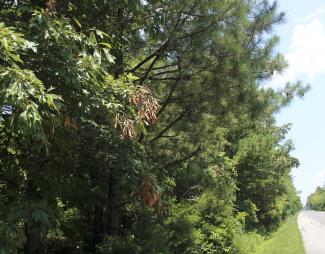|
Browning leaves on Oak Ridge Reservation harbinger of next cicada generation |
On the road leading to the Department of Energy’s Oak Ridge National Laboratory, drivers may notice that many of the green trees lining the entrance to the lab are dappled with brown leaves. At first glance, the sight isn’t extraordinary, as deciduous tree leaves turn hues of oranges and browns before falling to the ground each autumn. Yet, just weeks past the summer solstice, this phenomenon is out of place and is in fact evidence of another natural occurrence: cicada “flagging.” |

|
|
Population-specific diversity within fungi species could enable improved drug discovery |
Scientists at Oak Ridge National Laboratory and the University of Wisconsin–Madison have discovered that genetically distinct populations within the same species of fungi can produce unique mixes of secondary metabolites, which are organic compounds with applications in medicine, industry and agriculture. The finding could open new avenues for drug discovery and provide a deeper understanding of fungal evolution. |
|
|
Tiny but mighty precipitates toughen a structural alloy |
Scientists at the Department of Energy’s Oak Ridge National Laboratory and the University of Tennessee, Knoxville, have found a way to simultaneously increase the strength and ductility of an alloy by introducing tiny precipitates into its matrix and tuning their size and spacing. The precipitates are solids that separate from the metal mixture as the alloy cools. The results, published in the journal Nature, will open new avenues for advancing structural materials. |
|
|
Electric vehicles – Charged-up planning |
Researchers at Oak Ridge National Laboratory have developed a nationwide modeling tool to help infrastructure planners decide where and when to locate electric vehicle charging stations along interstate highways. The goal is to encourage the adoption of EVs for cross-country travel. |
|
|
Energy – Building a better thermostat |
Oak Ridge National Laboratory researchers designed and field-tested an algorithm that could help homeowners maintain comfortable temperatures year-round while minimizing utility costs. The algorithm learns over time to keep the home at residents’ desired temperature settings while minimizing energy costs and adjusting to environmental conditions, all with no existing knowledge of the building. Results suggest the algorithm could save homeowners as much as 25% on annual utility bills. |